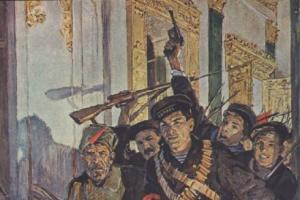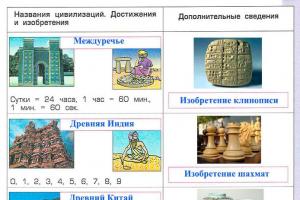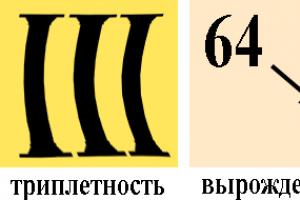In the process of personality formation, it is not upbringing that has a huge influence on its character and the peculiarities of perception of the world around it, but an innate property - temperament.
Let's talk about the type of temperament that psychologists call “luck” - sanguine people.
General concepts of temperament types
Temperament is an individual characteristic of a person, which depends on the speed of his psychophysical processes and the characteristics of the mental activity of his brain. Temperament is expressed in such qualities as the level of emotionality, activity, and the ability to contact the outside world and, in particular, with society.
Since antiquity, philosophers have shown a keen interest in the mental properties of humans, identifying several types of temperament.
The classification invented by Hippocrates, although recognized as imperfect, is still actively used to this day.
The great thinker believed that all people can be divided into four main psychotypes, in his understanding they were associated with physiological fluids inside the human body:
- Cholerics (bile) are unbalanced and irritable individuals.
- Melancholic people (black bile) are inert, weak and shy people.
- Phlegmatic people (mucus) are a calm and slightly slow type.
- Sanguine people (blood) are energetic and cheerful people.
Sanguine people are characterized as representatives of an “active” temperament and extroverts, focused on the surrounding reality. Let's look at a more detailed portrait of a sanguine person.
Sanguine
The famous Russian physiologist I.P. Pavlov determined the ability of a sanguine person to quickly change excitatory and inhibitory reactions, which manifest themselves more strongly than in a phlegmatic person, but more balanced than in a choleric person.
The rate of change in mental processes in such people is characterized by high activity, which is why this type of temperament manifests itself as energetic and emotional. At the same time, sanguine people have high social adaptability and behavioral flexibility.
Thus, a sanguine person is a cheerful and easy-to-communicate person who looks at the world with surprised eyes. The energy of sanguine people is in full swing, they rush to fill every minute with impressions, but at the same time in emergency situations they are able to act balanced and calm.
Determining the sanguine type of temperament is not difficult from the first days of life. Such a child will show himself incredibly active, experiencing a keen interest in everything around him. Parents of a sanguine child will have to test their patience, because he will require a lot of attention. Such people simply have to be in the center of events, surrounded by admiring glances.
Sanguine people easily take on new things, as they feel an urgent need to receive new emotions. At the same time, he will survive possible failures without any problems, without distancing himself from problems and without withdrawing into himself, like a phlegmatic person. A large number of interesting activities is a holiday for a sanguine person, because he will gladly take on each one.
Men and women with a sanguine temperament love meeting new people; they get along with people in a matter of minutes. This type simply charms those around him with his smile and open gaze. At the same time, sincere sanguine people treat literally everyone with love, which often causes jealousy on the part of people closer to them. But such an optimist cannot be limited in receiving bright emotions from acquaintances - he will become lethargic and uninteresting.
History knows many famous sanguine people who conquered the world with their abilities and determination: Napoleon Bonaparte, Wolfgang Amadeus Mozart, Mikhail Lermontov. There are famous sanguine people among fictional characters, a striking example of this is Winnie the Pooh.
Pros of temperament
The portrait of a sanguine person makes a pleasant impression, and it is not difficult to highlight the strengths of this type of temperament:
- He is the life of the party, he will easily find new friends and avoid conflicts with old ones.
- He has an extraordinary sense of humor and will easily cheer everyone up.
- He confidently moves towards his goal, without being upset by failures.
- He can do any business, as he shows curiosity and remarkable abilities about everything.
Temperament Flaws
Being sanguine is easy and pleasant, as it ensures the love of others and a constant charge of positive emotions.
Sanguine people are perceived by others much better than choleric or phlegmatic people, but this type of temperament should not be considered ideal, since it also has a number of disadvantages.

- He can sincerely make promises, but then forget about them.
- He can show frivolity and irresponsibility, so he often does not complete the task.
- He is slightly superficial, so he has many acquaintances, but not friends.
- Every day he needs admiration from others, so he has difficulty entering into permanent relationships and marriage.
Those who recognize a sanguine person in themselves or in their child should not be upset or, conversely, consider the situation to be too ideal. There are no people with a pure type of temperament. Usually in a personality portrait one of the psychotypes predominates, the other acts as an accent.
Therefore, if in most situations a person behaves like a typical sanguine person, in some moments he will begin to manifest himself as a choleric or phlegmatic person.
In addition, a typical sanguine person can be raised to be a responsible and serious person if you show him due attention and teach him to finish what he starts.
Compatibility and marriage
Men and women with a sanguine temperament easily start relationships, and in love they behave brightly and naturally, without burdening their partner with conflicts and quarrels. At the same time, long-term relationships for such people are a difficult task, because their temperament cannot withstand monotony. In addition, the many admiring fans of a sanguine person can often become a reason for jealousy on the part of his partner.
But, despite the opinion of psychologists about impermanence and the need to make new acquaintances, a sanguine woman can become an ideal wife. Her flexible character will conquer any man, and her charm and cheerful disposition will smooth out any adversity.
But you should be careful - such a woman will require a lot of attention to her person. She must always be surprised, given gifts and new impressions. If a woman gets bored, she will find a new man.
Psychologists believe that the most successful compatibility by temperament type is observed in a sanguine-sanguine couple. But this does not mean that other partners are not suitable for this psychotype. A person’s sanguine temperament will easily help him build relationships with both phlegmatic and choleric people. But in a pair with a melancholic person, there can be no question of compatibility - they are too different from a sanguine person.
Temperament is those innate human characteristics that determine the dynamic characteristics of the intensity and speed of reaction, the degree of emotional excitability and balance, and the characteristics of adaptation to the environment.
There are no better or worse temperaments - each of them has its own positive sides, therefore the main efforts should not be aimed at remaking the temperament (which is impossible due to the innateness of temperament), but at the reasonable use of its negative sides.
Humanity has long tried to identify the typical features of the mental make-up of various people, to reduce them to a small number of generalized portraits - types of temperament. Typologies of this kind were practically useful, since with their help it was possible to predict the behavior of people with a certain temperament in specific life situations.
Temperament translated from Latin means “mixture”, “proportionality”. The oldest description of temperaments belongs to the “father” of medicine, Hippocrates. He believed that a person’s temperament is determined by which of the four body fluids predominates: if blood (“sanguine”) predominates, then the temperament will be sanguine, i.e. energetic, fast, cheerful, sociable, easily endures life's difficulties and failures. If bile ("chole") predominates, then the person will be choleric - a bilious, irritable, excitable, unrestrained, very active person, with rapid mood swings. If mucus ("phlegm") predominates, then the temperament is phlegmatic - a calm, slow, balanced person, slowly, with difficulty switching from one type of activity to another, poorly adapting to new conditions. If black bile predominates ("melanchole"), then the result is a melancholic person - a somewhat painfully shy and impressionable person, prone to sadness, timidity, isolation, he gets tired quickly, and is overly sensitive to adversity.
Hippocrates generally correctly described the main types of temperament, but he could not provide a scientific basis for them.
The first classification of temperaments was proposed by the ancient Roman physician Gallen, and it has survived to this day in a relatively little changed form. The last known description of it, which is used in modern psychology, belongs to the German philosopher I. Kant, who, however, allowed a mixture of temperament and character traits in his interpretations.
The basis for the development of a truly scientific theory of temperament was developed by I.P. Pavlov (1849-1936) - the first Russian scientist to be awarded the Nobel Prize. Studying the work of the cerebral hemispheres, he established that all traits of temperament depend on the characteristics of a person’s higher nervous activity.
Pavlov and his students in their works identified three main properties of the nervous system: the strength of excitation or inhibition, mobility (the ability to quickly replace each other) and balance between excitation and inhibition. The combination of these properties leads to the formation of a certain type of temperament:
“uncontrollable” (strong, unbalanced, mobile type of nervous system (n/s), – corresponds to the temperament of a choleric person);
“lively” (strong, balanced, mobile type n/s - corresponds to the temperament of a sanguine person);
“calm” (strong, balanced, inert type n/s - corresponds to the temperament of a phlegmatic person);
“weak” (weak, unbalanced, sedentary type of n/s - determines the temperament of a melancholic person).
Psychological portrait of temperament types
Each individual type of temperament has its own characteristic features.
A sanguine person is a fast, active person who responds emotionally to all impressions; however, his joy, grief, sympathy and other feelings, although bright, are unstable and are easily replaced by opposite feelings. I.P. Pavlov characterized such people as follows: “A sanguine person is hot-tempered. A very productive worker, but only when he has a lot of interesting things to do, that is, there is constant excitement. When there is no such thing to do, he becomes boring and lethargic.”
A sanguine person is almost always the initiator in communication, immediately responds to the desire to communicate on the part of another person, but his attitude towards people can be changeable and fickle. He feels free in a large company of strangers; a new, unusual environment only excites him.
Examples include Stiva Oblonsky, the hero of the novel by L.N. Tolstoy "Anna Karenina", M.Yu. Lermontov and Napoleon.
A phlegmatic person is a slow, balanced and calm person. He is not easily touched emotionally and cannot be enraged. His feelings are almost never expressed outwardly. In relationships with other people, a phlegmatic person is calm and stable in his emotions. I.P. Pavlov noted: “A phlegmatic person is a calm, always even, persistent and persistent worker of life.” Let us remember Pierre Bezukhov from the novel by L.N. Tolstoy "War and Peace". But under certain conditions, indifference to work, surrounding life, and lack of will may develop (for example, Oblomov in the novel of the same name by I.A. Goncharov). A phlegmatic person shows little of his feelings and does not notice for a long time that someone is looking for a reason to get to know him. But he is stable and constant in his attitude towards people, loves to be in a narrow circle of old acquaintances, in a familiar environment.
Phlegmatic people were I.A. Krylov and M.I. Kutuzov.
A choleric person is a fast, impetuous person, with strong feelings that are reflected in expressive facial expressions, gestures, and speech. He is often prone to violent emotional outbursts. Choleric people experience rapid mood swings and imbalance, which is explained by the predominance of excitation processes over inhibition. I.P. Pavlov defined this type of temperament as follows: “The fighting type, perky, easily and quickly irritated” (a striking example of this type is Prince Bolkonsky in L.N. Tolstoy’s novel “War and Peace”).
Starting a business with enthusiasm, the choleric quickly cools down, interest in the work disappears, and he continues without inspiration, and sometimes even abandons it. People of choleric temperament can be difficult to communicate with.
A.S. Pushkin and A.V. Suvorov is choleric.
A melancholic person does not respond emotionally to everything. He has a small variety of emotional experiences, but these experiences differ in depth, strength and duration. She worries a lot, although she doesn’t express her feelings outwardly much (for example, Princess Marya in L.N. Tolstoy’s novel “War and Peace”). I.P. Pavlov noted that a melancholic person, “finding himself in new living conditions, becomes very lost.” In a familiar, calm environment, people of this type work very productively and are distinguished by the depth and content of their emotional and moral behavior and attitude towards the people around them. Melancholic people are very touchy and have a hard time dealing with failures. They are prone to isolation, loneliness, feel awkward in a new, unusual environment, and are often embarrassed. P.I. Tchaikovsky is melancholic.
A psychological portrait is a verbal description of a personality that contains characteristics of an individual and his likely behavior under certain circumstances. Detailed information about a person is needed when choosing a profession, hiring an employee for a certain position, in marriage agencies, to determine the prospects for a joint family life. A psychological portrait of a person is compiled based on the results of tests, various questionnaires (Cattell, Mehrabian, Eysenck) and communication with a psychologist.
Why is a psychological personality portrait used?
The psychological portrait plays a fundamental role when choosing a future occupation. Before entering an educational institution, you need to find out in which area a person can achieve great success. After all, nothing good will come of doing something you don’t like.
Thanks to a well-compiled psychological report, interested parties can get to know a person better and understand the motives of his behavior. With the help of such a description, it is possible to identify lies, a tendency to conflict, strong and weak character traits.
Many managers, when hiring for a vacant position, test candidates to determine the qualities and abilities of the applicants. It is important for managers to know how a person will act in a difficult situation, whether he will be able to solve problems, and whether the individual has the character traits necessary to complete the task.
A psychological portrait of a child will help a teacher find an approach to his student. If adults want to reach the hearts of children, they need to know. Having determined the type of temperament of each child, you can competently plan the process of raising him.
Psychologists, at the client’s request, draw up a psychological portrait of a person in order to find him a suitable life partner. After all, it is known that two polar personalities will not be able to build harmonious relationships. If partners want to avoid conflicts and misunderstandings, they must have similar values, a suitable temperament, think alike and work together towards a cherished goal.
The main components of a psychological portrait of a personality
Before outlining a psychological portrait of an individual, you should find out what criteria make it up. Every person inhabiting the planet is an individual. Every individual has basic and programming characteristics. The basic criteria are the temperament, character, and abilities of the individual. Programming criteria are focus, intelligence and self-awareness.
Individuals, depending on their susceptibility, are divided into the following types:
- Present-oriented.
They easily get used to any role and are able to adapt to any situation. They make the right decisions quickly.
- Past-oriented.
They act in accordance with established rules and laws. Good performers.
- Future-oriented.
May demonstrate inappropriate behavior. They don't accept hierarchy. They are the authors of many ideas.
Components of a psychological portrait of a personality:
- Temperament.
Based on the specific characteristics of the nervous system. Determines the behavior pattern of an individual. His features are difficult to correct. There are 4 types of temperament: sanguine (balanced psyche, flexible behavior, liveliness), choleric (emotionality, mood swings, thirst for novelty), phlegmatic (inertia, poise, shyness), melancholic (vulnerable psyche, pessimism, vulnerable nervous system).
- Character.
These are the original characteristics of each individual. Character is manifested in communication and in the process of social activity. For each individual, a characteristic is drawn up based on his attitude to the following aspects of life: work (laziness, hard work), people (sociability, isolation), himself (selfishness, modesty), objects of the material sphere (stinginess, generosity).
- Capabilities.
These are the individual properties of an individual. Thanks to their abilities, people achieve success in a certain area of life. Abilities develop through training.
- Directionality.
It is based on motivation. It determines the activities and behavior of the individual. Orientation is focused on some task, communication or on oneself. Some individuals strive to satisfy their physiological needs and provide themselves with comfortable living conditions. Others are looking for themselves in various areas of social activity, trying to realize their creative abilities.
- Emotionality.
Its essence is a person’s involuntary reaction to external stimuli. They arise beyond the will and desire of the individual. Experiences about a certain situation reflect the depth of significance of various events for an individual. A strong-willed person must be able to suppress his emotions and not show his true feelings to others.
- Intelligence.
Determines the level of education of an individual. Depends on the knowledge gained, age, specifics of the profession. Thanks to intelligence, an unfamiliar situation is assessed, important decisions are made, and behavior is regulated. With the help of intelligence, an individual adapts to a new environment and correctly builds his relationships with other people. Intelligence is the ability to think rationally and act appropriately to the situation.
- Communication skills.
The ability to communicate is an important character trait. Communication reveals the individual characteristics of people. Thanks to communication, information, information about the feelings, thoughts, and knowledge of the subjects of the conversation are transferred.
- Self-esteem.
Based on self-analysis, the individual develops an emotional and value-based attitude towards his own person. Self-esteem can be adequate, overestimated or underestimated. An individual evaluates his own abilities, achievements, and his place in society.
If you have identified low self-esteem, then you should contact a specialist, for example, psychologist-hypnologist Nikita Valerievich Baturin.
- Volitional qualities.
Character qualities influence people's lives and actions. Strong-willed individuals make their own decisions, are not afraid of difficulties, they are decisive and persistent. Weak-willed people are often weak-willed. Such individuals fail to realize themselves in society, although they have all
- Self-control.
A person’s upbringing and ability to lead in society depend on self-control. People who cannot control their feelings, words, and behavior are not able to build friendly or partnership relationships with others.
- Ability to work together.
Different individuals have different abilities for collective work. The ability to work in a team is the ability to adapt to other people, to listen to a different point of view.
How is a psychological portrait of a person compiled?
In order to correctly draw up a psychological portrait of an individual, you should adhere to the following rules:
- the method of studying an individual must correspond to the purpose of the experiment, the person’s age, and level of education;
- in addition to a personal conversation with the individual, you need to use two personality questionnaires and three projective methods;
- based on the results of all studies, compare the data and trace their correlation;
- create comfortable testing conditions for the individual being examined;
- draw up a portrait so that its text is understandable to people who do not have a psychological education.
What methods are used to draw up the necessary psychological portrait:
- study of the emotional-volitional sphere - the SAN method, the Spielberg, Bas-Darka, Nemchin test;
- research in the cognitive-cognitive area - intelligence test, Wechsler, memorizing 10 words, eliminating the superfluous, equality matrices, Schulte tables;
- examination of the interpersonal-social sphere - Etkind color test, Bales method, Leary, sociometry;
- study of motivations and needs - the Eagle method, types of work motivation according to Gerchikov, career anchors, 14 basic needs according to Murray.
What projective techniques are used in studying the inner world and transferring its content to the outer:
- drawing “house, tree, man”;
- the image of a fictional animal;
- psychogeometry;
- Rorschach blots.
What personality questionnaires are used to identify certain characteristics in an individual:
- Leonard test;
- Cattell's 16-factor questionnaire;
- MMPI (full or short version).
- initials of the subject, his age, profession;
- purpose of the study (for example, to determine suitability for the position held);
- the techniques that were used;
- the individual’s behavior during testing (hand trembling, severe anxiety);
- research results;
- psychological characteristics of the individual and prognosis regarding his behavior;
- conclusions, wishes, recommendations.
An example of writing a psychological portrait of a personality
Only an experienced psychologist can draw up a psychological portrait of any personality. The specialist chooses one that corresponds to the purpose of a particular study. In order to analyze yourself yourself, you should use simplified methods, for example, testing DISC personality typology or socionics. Similar tests can be easily found on the Internet and taken online. With their help you can find out your character type.
An example of a psychological portrait of a personality based on questionnaires by Cattell, Mehrabian, and Eysenck:
- Elena Nikiforova, 20 years old, student;
- character traits: sociable, has many friends, good-natured, emotional, often acts under the influence of emotions, impulsive, prone to aggression;
- temperament: according to the Eysenck questionnaire, sanguine, easy to meet and communicate, adapts well to unusual living conditions;
- intelligence: according to the results of the Cattell questionnaire, intelligence is above average, has abstract thinking, excellent intelligence, quickly perceives new information;
- motivation: according to the questionnaire, Mehrabian is motivated to achieve her goal, that is, success;
- emotional stability: average, easily excited, too emotional, unyielding, irritable;
- communication skills: talkative, active, often distrustful, prone to leadership, independent, knows how to behave in a new team;
- summing up: the test results are within the normal range, attention should be paid to the excessive suspicion and inflexibility of the subject being studied.
Self-instructor in psychology Obraztsova Lyudmila Nikolaevna
Phlegmatic temperament
Phlegmatic temperament
At first glance, a phlegmatic person is the exact opposite of a choleric person. Upon careful examination, many similar traits are revealed in the owners of these temperaments. This is, first of all, their persistence and desire to always achieve their goals. The only difference is the speed at which they do it. If a choleric person always overcomes obstacles on his way “at once,” quickly and recklessly, then a phlegmatic person acts very slowly and carefully, having carefully weighed all the pros and cons before doing so. Plans never “emerge” in his head, he painstakingly builds them, then nurtures them for a long time, and only then, after praying and rolling up his sleeves, he begins to implement them.
A phlegmatic person is not a warrior, but a creator. He is very peaceful, or at least too passive to enter into conflict. But this does not mean that he will obey all the demands of those around him: in terms of stubbornness, phlegmatic people are perhaps superior to representatives of any other temperament. If you express your dissatisfaction with his actions and try to change his plans, he will not argue or bicker with you - he will simply silently and persistently continue to follow his chosen path.
It is very difficult to make a phlegmatic person angry, and we do not advise you to even try to do this: if your attempt is crowned with success, then this “success” will be not only the first, but also the last - an angry phlegmatic person will not leave a wet spot on you. A slow and complacent, awkward and slightly funny phlegmatic person in a state of rage is transformed beyond recognition; he will simply crush the one who dares to disturb his peace. Fortunately, it is almost impossible to bring a phlegmatic person to such a state.
Portrait of a phlegmatic man
Closed, reserved, silent; peaceful, reliable, constant; slow, conformist; purposeful, patient, persistent, stubborn, pragmatic.
How to communicate with a phlegmatic person:
- do not demand quick decisions and actions from him - quick reactions are completely inaccessible to him. This is a biological property, and not laziness, absent-mindedness or anything else of the same kind. All meetings and events in which a phlegmatic person takes part should be planned taking into account this feature;
- Likewise, be sure to notify him of all your plans in advance: he needs time not only to get ready for a visit, but also to generally get used to the idea of the upcoming visit. Phlegmatic people do not tolerate any surprise;
– never try to “re-educate” him. This should not be done with anyone at all and never, but with phlegmatic people such behavior is especially unacceptable. If a sanguine person has a very developed ability to adapt to the demands of others, and a choleric person can at least be interested and captivated by something extraordinary, then a phlegmatic person recognizes only his choice and his path. At best, you will waste your time and energy trying to convince him, and at worst (if your complaints about him reach some critical mass) you will provoke an explosion of indescribable force.
Advantages and disadvantages:
The phlegmatic is the most efficient of all temperament types, and his labor productivity turns out to be the highest. This remarkable performance can be damaged by frequent changes in working conditions and contradictory requirements. The need to quickly make decisions puts a phlegmatic person in a very uncomfortable position, but this does not mean that he can only be good as a performer. Where it is necessary to maintain stable processes (and not search for new opportunities), a reliable and confident phlegmatic person can cope well with leadership work.
"Typical" appearance
A dense, well-built figure, massive build, well-developed muscles, arms and legs of short or medium length, often a tendency to be overweight, a short and wide chest; wide angular skull, large nose, short neck.
Personalities
M. I. Kutuzov, I. A. Krylov
From the book General Psychology author Pervushina Olga NikolaevnaTEMPERAMENT Temperament is the biological foundation on which personality is formed. It reflects the dynamic aspects of behavior, mainly of an innate nature.B. S. Merlin considers individual characteristics as properties of temperament, which1) regulate
From the book How to find out and change your destiny author Litvak Mikhail Efimovich3. Temperament Temperament is constant and stable, individually unique natural properties of a person that determine the dynamics of mental activity, regardless of its content. Sanguine, choleric, phlegmatic, melancholic are the main types of temperament. What are
From the book Psychological Safety: A Study Guide author Solomin Valery PavlovichTEMPERAMENT Temperament (Latin temperamentum - proper ratio of parts, proportionality) is an individual property of the psyche that determines the dynamics of human activity and the pace of mental processes. Distinctive signs of temperament are, firstly,
From the book Psychology: lecture notes author Bogachkina Natalia Alexandrovna1. Temperament 1. History of ideas about temperament.2. Types of temperaments. Properties of temperaments.3. Individual style of activity.4. Temperament and problems of education.1. Temperament is a combination of properties that determine the dynamics of functioning
From the book How to Read a Person. Facial features, gestures, postures, facial expressions author Ravensky Nikolay From the book Developmental Psychology [Research Methods] by Miller Scott From the book Psychology: Cheat Sheet author author unknown From the book Psychology and Pedagogy: Cheat Sheet author author unknown From the book Humanistic Psychoanalysis author Fromm Erich Seligmann From the book Fundamentals of Underworld Psychology-2. Volume II author Polozenko O V6.1 TEMPERAMENT 1. Understand about temperament.2. Physiological basis of temperament.3. Psychological characteristics of temperament.4. Heads of power to temperament.5. Temperament and personality.6. Infusing temperament into activity
From the book Self-Teacher on Psychology author Obraztsova Lyudmila NikolaevnaMelancholic temperament Melancholic people are extremely vulnerable creatures. It is perhaps more difficult to get along with melancholic people than with anyone else. Although, at first glance, their character lacks many of the “problematic” traits of other temperaments: they, unlike
From the book Man for Himself author Fromm Erich Seligmann From the book Psychology. Textbook for high school. author Teplov B. M.§77. Temperament Since ancient times, it has been customary to distinguish four main temperaments: choleric, sanguine, melancholic and phlegmatic. Temperament refers to the individual characteristics of a person, expressed in: 1) emotional excitability
From the book How to Raise a Son. A book for sensible parents author Surzhenko Leonid Anatolievich From the book Family Raising a Child and Its Importance author Lesgaft Peter FrantsevichTEMPERAMENT Temperament can be called the degree of actions and feelings manifested by an individual, and the distribution of this manifestation over time, that is, the strength and speed of manifestations of actions and feelings, as well as the strength and speed of development of the desires of an individual. Can
From the book Fundamentals of Psychology author Ovsyannikova Elena Alexandrovna6.1. Temperament The concept of temperament. Human behavior depends not only on social conditions, but also on the characteristics of its natural organization. Among the individual characteristics that characterize human behavior, his activities and communication, a special place
How to write a psychological portrait of a personality? Examples on this topic are quite varied, but before providing them, it should be remembered that each person has a certain choleric, sanguine, melancholic and phlegmatic. It has been proven that in its pure form belonging to one or another type of nervous activity is rare. Most often, one individual combines a set of personal qualities that can be adjusted.
However, the basis of temperament remains constant. How can this be tracked in practice? Before assessing the psychological portrait of a person, the writing example should focus on how a person navigates society. One goes through life without deviating from clear rules, the other, on the contrary, is creative and resorts to innovative methods.
Psychologists are unanimous in their opinion that we should start with a description of temperament. Without this, it is impossible to create a psychological portrait of a person. A pattern of any characteristic primarily reflects the type of nervous system.
Sanguines and cholerics
Each type of temperament has its own characteristics, so each personality requires an individual approach. Sanguine people have a strong nervous system and easily experience changes in mental processes: their excitement quickly gives way to inhibition and vice versa. Because of this, they tend not to always fulfill their promises and need control.

But their positive traits usually outweigh the negative ones. Such individuals are endowed with sociability, sociability and optimism. In most cases, sanguine people are leaders and often occupy leadership positions in social life.
Cholerics are known for their unbalanced nervous system. The process of excitation in them prevails over inhibition. Cholerics feel the need to be busy all the time. They, like sanguine people, strive for leadership, but are often too assertive and hot-tempered.
Therefore, others often find choleric people aggressive and conflict-ridden. However, one can only envy their energy and determination. They are recommended to realize themselves in society as military personnel, rescuers, and doctors.
Phlegmatic and melancholic
During the research, scientists came to the conclusion that phlegmatic people are endowed with a strong type of nervous system. But, unlike sanguine people, these individuals are inert. They take a long time to make a decision and slowly assess their strength.

It is important not to push phlegmatic people, otherwise they will become very irritated and may quit what they started. Many believe that these individuals are often prone to succumbing to dark thoughts. But in reality they rarely become depressed. Their positive traits are consistency, reliability and thoroughness.
Melancholic people are the owners of a weak, unbalanced type of nervous system.
They are very sensitive and tend to get upset when pressured or given harsh instructions. Due to their softness, melancholic people often cannot resist the dictator and withdraw into themselves.
This eloquently reflects their psychological portrait of personality. An example from psychology shows that it is important for such individuals to master professions related to communication and caring for others. After all, the distinctive features of melancholic people are the ability to empathize and show mercy.
Psychological portrait of personality. Writing example
Perhaps many readers will think: “Is personality characteristics really that important today?” In fact, social life requires realization from the individual. Moreover, it is important that the activity is not only useful and well-paid, but also brings moral satisfaction to the person.
Platonov’s method can help a modern employer competently involve each team member in the process of activity. For example, the scientist emphasizes that a phlegmatic person works best with a melancholic person, and a choleric person works best with a sanguine person. In addition, Platonov identified important points from the structure of a person’s character:
- In this case, a person’s hard work, responsibility, and initiative are assessed. The main question is whether he realizes his natural potential or not.
- Attitude towards others. It is known that the production process is based on relationships, and the coherence of the work and the final result depend on how harmonious they are. Therefore, it is assessed how responsive, respectful and flexible an individual is in society.
- Attitude towards yourself. Today, the motto “love yourself” remains relevant. After all, a person who cares about his appearance and a healthy lifestyle not only evokes pleasant emotions, but is also able to attract positive events. That is why a newcomer is advised to pay attention to his appearance when he is going for an interview.
Example characteristics

Based on the above, we can conclude: everyone is able to create a psychological portrait of a person. An example of writing about yourself might look like this: “The basis of my temperament is melancholic. I am moderately hardworking and responsible. The downside is suspiciousness, which prevents me from achieving success. I act according to my natural potential and am able to develop self-confidence through psychological training. Relationships in the team do not always work out well. I am friendly, but shy, and have difficulty defending my opinion. I’m quite picky about myself, I doubt a lot of things, I have several bad habits, but I’m trying to get rid of them.”
This method helps an individual overcome psychological barriers, adjust their behavior and change a lot in their life for the better. The manager, in turn, often focuses on the psychological portrait of the individual. The writing sample usually assumes a free form, but there are large companies that provide a service sample.
How does Platonov's method work in psychology?
In fact, the described method is successfully used in the field of psychiatry and psychology. After all, before helping a person solve his problem, a specialist characterizes his personal qualities.

So, how to write a psychological portrait of a personality? Examples of this are quite varied. One of them implies, in addition to describing the type of temperament, also defining the emotional side of human character. For example, experts consider 4 types of emotions: demonstrative, pedantic, stuck, excitable.
The demonstrative type is distinguished by its emotionality. Such people vigorously express their emotions and often “play to the public.” But thanks to their artistry, they are able to understand their interlocutor well. Therefore, if a representative of the demonstrative type turned to a specialist for help with a request to help him decide on his choice of profession, then the most successful recommendation for him is to choose public activity. Or you can master a specialty
The pedantic personality type is prone to indecisiveness and a constant feeling of fear. He is characterized by hesitation and doubt. However, punctuality, prudence and accuracy are taken by the specialist as a basis and help to offer this type a certain method of resolving the situation.
Two difficult types

Are there any difficulties when drawing up a psychological portrait of a person? An example of writing according to Platonov shows: yes, this happens. For example, there are 2 personality types: stuck and excitable. At first glance they are similar.
And some individuals are able to intertwine in character. But a professional in his field is still able to figure it out. For example, stuck-type individuals are distinguished by the fact that they are able not to demonstrate their negative emotions for a long time. “Revenge is a dish best served cold” is an expression that perfectly describes their condition. Such individuals are touchy and vindictive. First of all, they are offered programs to get rid of old grievances.
An excitable personality type manifests itself in constant dissatisfaction and irritability. These negative phenomena lead to the fact that the individual is in conflict with the outside world and himself. What leads to this condition? The psychologist carefully works with the applicant, trying to piece together all the details of life events, taking into account his temperament, genetic characteristics, social conditions and circle of acquaintances.
Platonov's method in society

Palatonov’s method is used in various creative shows, politics, and science. Indeed, in this activity, the psychological portrait is primarily important. It is impossible for a famous person, just like an ordinary person, to avoid such a characteristic. In this case, the scientist Platonov proposes to consider a person’s intelligence and orientation.
That is, does he have a certain talent and will he be able to realize it based on willpower? In addition, experts take into account a person’s ability to manage their emotions and control their moods and feelings.
Self-esteem is the basis of characteristics
Experts pay special attention to the individual’s self-esteem. Many types of social activities place special emphasis on this when they compile a psychological portrait of an individual. Example of writing: “Ivan Stepanovich Korolev has high mathematical abilities, but low self-esteem. Can he manage a team? At present, no."
This is not the entire list of issues that Konstantin Platonov touches on in his works. The description of a person’s personal qualities depends on the circumstances and the field of activity that requires them. As a rule, a psychological portrait is individual and can be confidential.








